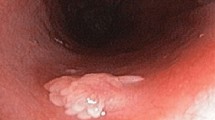Abstract
Background
Previous studies have found an increased risk for colonic neoplasm in patients with Barrett’s esophagus. It is unknown whether such risk applies similarly to other types of gastroesophageal reflux disease (GERD).
Aims
To test whether GERD represents a risk factor for the occurrence of colon polyps.
Methods
The Miraca Life Sciences Database is a large national electronic repository of histopathologic records of patients distributed throughout the entire USA. A case–control study evaluated whether presence of (1) Barrett’s metaplasia, (2) erosive esophagitis on endoscopy or histologic signs of reflux esophagitis, (3) clinical diagnosis of GERD, (4) any type of GERD affected the occurrence hyperplastic polyps (HP), sessile serrated adenomas/polyps (SSA/P), or tubular adenomas (TA) among 228,506 subjects undergoing bidirectional endoscopy. Multivariate logistic regression analyses were used to calculate odds ratios and their 95% confidence intervals for the risk of HP, TA or SSA/P associated with various types of GERD and adjusted for age, sex, and presence of H. pylori.
Results
The analysis revealed positive associations between GERD and all types of colon polyps. These associations applied similarly to HP (1.47, 1.44–1.50), TA (1.30, 1.27–1.32), and SSA/P (1.52, 1.46–1.58). They also applied to different forms of GERD, showing a trend toward stronger associations, that is higher odds ratios, with Barrett’s metaplasia or erosive esophagitis than clinical diagnosis of GERD.
Conclusion
All types of GERD represent a risk factor for the occurrence of different colon polyps, such as HP, TA, or SSA/P.
Similar content being viewed by others
References
Sontag SJ, Schnell TG, Chejfec G, et al. Barrett’s oesophagus and colonic tumours. Lancet. 1985;1:946–949.
Siersema PD, Yu S, Sahbaie P, et al. Colorectal neoplasia in veterans is associated with Barrett’s esophagus but not with proton-pump inhibitor or aspirin/NSAID use. Gastrointest Endosc. 2006;63:581–586.
Bollschweiler E, Schloesser T, Leers J, Vallböhmer D, Schäfer H, Hölscher AH. High prevalence of colonic polyps in white males with esophageal adenocarcinoma. Dis Colon Rectum. 2009;52:299–304.
de Jonge PJ, van Blankenstein M, Looman CW, Casparie MK, Meijer GA, Kuipers EJ. Risk of colorectal cancer in patients with Barrett’s esophagus: a Dutch population-based study. Am J Gastroenterol. 2010;105:77–83.
Sonnenberg A, Genta RM. Barrett’s metaplasia and colonic neoplasms—a significant association in a 203,534-patient study. Dig Dis Sci. 2013;58:2046–2051.
Ismail-Beigi F, Horton PF, Pope CE 2nd. Histological consequences of gastroesophageal reflux in man. Gastroenterology. 1970;58:163–174.
Srivastava A, Odze RD, Lauwers GY, Redston M, Antonioli DA, Glickman JN. Morphologic features are useful in distinguishing Barrett esophagus from carditis with intestinal metaplasia. Am J Surg Pathol. 2007;31:1733–1741.
Dixon MF, Genta RM, Yardley JH, Correa P. Classification and grading of gastritis: the updated Sydney system. Am J Surg Pathol. 1996;120:1161–1181.
Lash RH, Genta RM, Schuler CM. Sessile serrated adenomas: prevalence of dysplasia and carcinoma in 2139 patients. J Clin Pathol. 2010;63:681–686.
Rex DK, Ahnen DJ, Baron JA, et al. Serrated lesions of the colorectum: review and recommendations from an expert panel. Am J Gastroenterol. 2012;107:1315–1330.
Achkar JP, Post AB, Achkar E, Carey WD. Risk of extraesophageal malignancy in patients with adenocarcinoma arising in Barrett’s esophagus. Am J Gastroenterol. 1995;90:39–43.
Camilleri M, Malhi H, Acosta A. Gastrointestinal complications of obesity. Gastroenterology. 2017;152:1656–1670.
Bernstein H, Bernstein C, Payne CM, Dvorak K. Bile acids as endogenous etiologic agents in gastrointestinal cancer. World J Gastroenterol. 2009;15:3329–3340.
McQuaid KR, Laine L, Fennerty MB, Souza R, Spechler SJ. Systematic review: the role of bile acids in the pathogenesis of gastro-oesophageal reflux disease and related neoplasia. Aliment Pharmacol Ther. 2011;34:146–165.
Thorburn CM, Friedman GD, Dickinson CJ, Vogelman JH, Orentreich N, Parsonnet J. Gastrin and colorectal cancer: a prospective study. Gastroenterology. 1998;115:275–280.
Sonnenberg A, Genta RM. Helicobacter pylori is a risk factor for colonic neoplasms. Am J Gastroenterol. 2013;108:208–215.
Graham DY, Opekun AR, Osato MS, et al. Challenge model for Helicobacter pylori infection in human volunteers. Gut. 2004;53:1235–1243.
Yap TW, Gan HM, Lee YP, et al. Helicobacter pylori eradication causes perturbation of the human gut microbiome in young adults. PLoS One. 2016;11:e0151893.
Kienesberger S, Cox LM, Livanos A, et al. Gastric Helicobacter pylori infection affects local and distant microbial populations and host responses. Cell Rep. 2016;16:1395–1407.
Garrett WS. Cancer and the microbiota. Science. 2015;348:80–86.
Genta RM, Schuler CM, Robiou CI, Lash RH. No association between gastric fundic gland polyps and gastrointestinal neoplasia in a study of over 100,000 patients. Clin Gastroenterol Hepatol. 2009;7:849–854.
Hsu WH, Wu IC, Kuo CH, et al. Influence of proton pump inhibitor use in gastrointestinal polyps. Kaohsiung J Med Sci. 2010;26:76–83.
Author information
Authors and Affiliations
Contributions
AS and RMG were involved in study conception and design; AS, RMG, and KOT analyzed the data; and AS and RMG wrote the manuscript.
Corresponding author
Ethics declarations
Conflict of interest
A. Sonnenberg has no conflict of interest to declare. K.O. Turner and R.M. Genta are employed by Miraca Life Sciences, Irving, TX.
Rights and permissions
About this article
Cite this article
Sonnenberg, A., Turner, K.O. & Genta, R.M. Increased Risk for Colon Polyps in Patients with Reflux Disease. Dig Dis Sci 63, 228–233 (2018). https://doi.org/10.1007/s10620-017-4841-2
Received:
Accepted:
Published:
Issue Date:
DOI: https://doi.org/10.1007/s10620-017-4841-2




